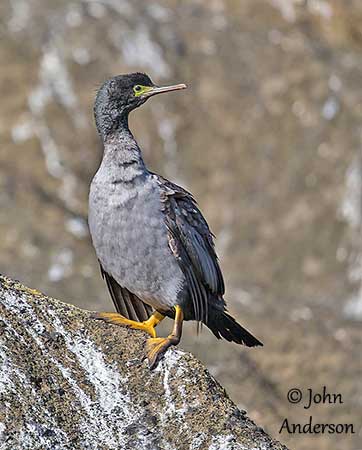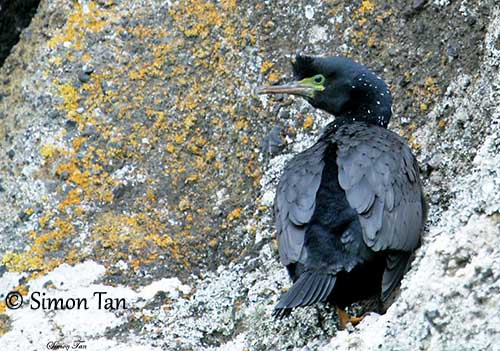
Fr: Cormoran de Featherston
Ang: Pitt Island Shag
All: Pittscharbe
Esp: Cormorán de la Pitt
Ita: Cormorano dell'Isola Chatham
Nd: Chathamaalscholver
Sd: Pittskarv
Photographers:
John Anderson
John Anderson Photo Galleries
Simon Tan
PBase Bird galleries
Alan & Ann Tate
AA Bird Photography
Text by Nicole Bouglouan
Sources:
HANDBOOK OF THE BIRDS OF THE WORLD vol 1 by Josep del Hoyo-Andrew Elliot-Jordi Sargatal - Lynx Edicions - ISBN: 8487334105
BirdLife International (BirdLife International)
Te Ara – The Encyclopedia of New Zealand
Page family Phalacrocoracidae
Summary cards
Pitt Island Shag
Phalacrocorax featherstoni
Suliformes Order – Phalacrocoracidae Family
INTRODUCTION :
The Pitt Island Shag is endemic to the Chatham Islands. It belongs to the “yellow-footed” group.
They breed in small colonies on coastal cliffs where the eroded holes in the volcanic rocks provide them sheltered sites from predators and bad weather.
It was formerly a subspecies of the Spotted Shag (P. punctatus).
DESCRIPTION OF THE BIRD:
Biometrics:
Length: 63 cm
Weight: 650-1300 g
The adult is the only “yellow-footed” shag in the Chatham Islands group. It is slender and darker than the Spotted Shag.
On the upperparts, head, upperneck and back to uppertail-coverts are black with conspicuous steel-blue gloss. Mantle, scapulars and wings are paler, and the mantel shows a dull bronze sheen. On the upperwing, the wing-coverts have small black spot at tip. The tail is blackish.
We can see scattered white filoplumes on head and neck, but mainly on the hindneck.

Both sexes are similar. As the breeding season progresses, the white filoplumes and the crests are reduced and lost towards the end of this period. The dark areas of the plumage become browner. The facial skin is mostly dull orangey outside the breeding season.
The juvenile is dark brown overall with darker head, neck, back, rump, uppertail-coverts and thighs. Scapulars, wing-coverts and tertials show paler brown tips.
The underparts are pale brownish with a mid-brown breast band.
On the head, the area below the eye and the forehead are pale brown. The bill is dark. Facial skin, legs and feet are like in non-breeding adults.
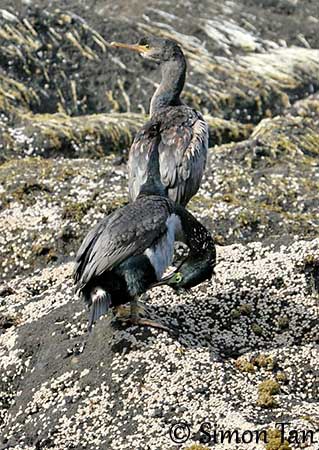
BEHAVIOUR IN THE WILD:
The Pitt Island Shag feeds mainly on small fish, but also on marine invertebrates (snails and worms) and crustaceans.
It forages in offshore coastal waters, among kelp, and usually alone. It feeds by pursuit-diving, swimming on surface and foraging underwater.
The displays of this species are unknown, but we can suggest that they are similar to those of other shags and cormorants, with wing-waving and gargling. These postures enhance the head pattern and the shiny plumage.
The Pitt Island Shag is sedentary and remains within the coastal waters around the Chatham Islands.
In flight, head and neck are held horizontally. Over water, it usually flies low over the surface.
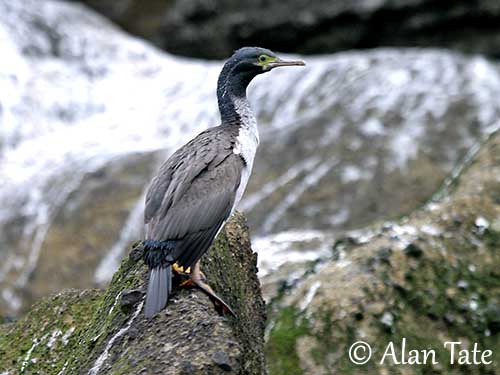
REPRODUCTION OF THIS SPECIES:
The breeding season occurs from August to December.
The Pitt Island Shag breeds in loose colonies of 5 to 40 pairs, established on coastal cliffs and rocky islets. The nest is built on rocky ledges or in crevices, and in eroded pockets in volcanic rocks. These natural cavities provide them shelter from predators and weather.
The nest is made with seaweeds and twigs, and other materials available near the nest-site.
The female lays 3 pale blue eggs. The incubation is shared by both parents and lasts about one month. At hatching, the chicks are naked, but they are quickly covered with grey-black down.
One parent guards the chick during the first two weeks. Then, both adults forage together and feed the chicks by regurgitation. The young fledge about 6-8 weeks after hatching.
The nest is strongly defended by the adults against intruders.
PROTECTION / THREATS / STATUS:
The Pitt Island Shag has reduced range, and its small population is estimated at about 1400 individuals. They are threatened by human persecutions, changes in their marine environment which affect the food resources, and climate change.
As the nests are placed in inaccessible sites, the Pitt Island Shag is not usually affected by predators, and only some nests placed lower may be vulnerable.
Conservation actions are necessary in order to protect this species which is currently listed as Endangered.
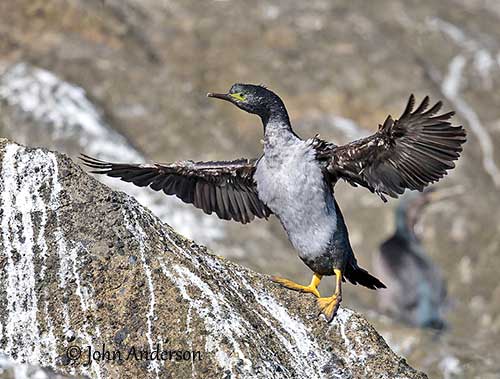
RANGE:
The Pitt Island Shag breeds in the Chatham Islands on several islands such as Chatham, Pitt and offshore islets, Rangatira, Mangere and Little Mangere Islands, and Western Reef, the Castle, Star Keys, Sisters and Forty Fours.
They forage throughout the coastal waters.
HABITAT:
The Pitt Island Shag breeds on the coastal cliffs, usually in crevices, on ledges or in holes in the rock. It roosts in groups of up to 100 birds on headlands and coastal rock stacks.
It forages at sea in coastal waters, although a small colony occurs in the brackish waters of the Te Whanga Lagoon where the birds forage in the deeper part of the lagoon.
CALLS AND SONGS: SOUNDS BY XENO-CANTO
The Pitt Island Shag male becomes noisy during the breeding season at colonies. It produces a large variety of sounds such as grunting, gargling “argh-argh-argh”, and ticking notes. The female is silent at colonies, and both sexes are silent away from the colonies.
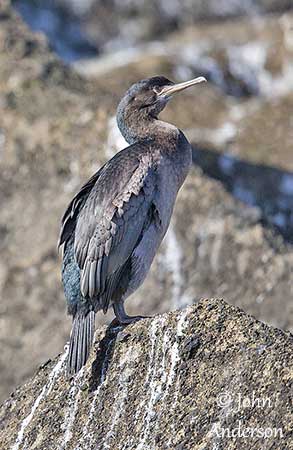
On the underparts, lower foreneck and belly are pale grey. Vent, undertail-coverts and thighs are black with steel-blue gloss.
On the black head, there are two upcurved crests, one on the forecrown and the other on the nape. The facial skin, including lores, eyering and base of upper mandible, is lime-green, becoming bluish below the gape. The gular pouch is sometimes sky blue.
The slender bill is blackish to dark brownish. The eyes are dark brown. Legs and webbed feet are orange or dull yellow, with variable dark markings on feet.
